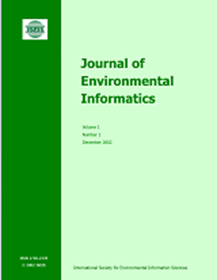利用卫星遥感和机器学习技术进行降水预测和植被分类
IF 5.4
1区 环境科学与生态学
Q1 ENVIRONMENTAL SCIENCES
引用次数: 8
摘要
在全球范围内,降水事件的空间分布、规模和时间正在发生变化,往往导致极端水文条件,对生态系统服务、水、粮食和能源安全以及数十亿人的福祉产生严重影响。为了从水文生态学的角度了解水文循环的动态性质将如何影响缺水地区的环境,我们实施了一种基于其他主要水文成分(如植被含水量(VWC)、土壤湿度(SM)和地表温度(ST))预测东非干旱地区降水时空趋势的新方法。以2003-2011年东非不同植被类型和不同降水强度率的区域为研究对象,研究了上述4个水文变量间相互关系的空间格局和特征。为此,我们分析了SM、ST和VWC的多年卫星微波遥感观测(来自海军研究实验室的WindSat辐射计)以及它们对降水模式的响应(来自美国宇航局的TRMM 3B42 V7)。我们将降水分为强度的四个桶(范围),并为每个类别训练了五个不同的最先进的机器学习模型。然后将模型应用于该复杂区域的时空降水动态预测。具体来说,随机森林和线性回归模型的表现优于其他模型,所有类别的归一化平均绝对误差小于27%。预测降水的特征又被用来对东非的植被制度进行分类。结果表明,不同数值的模型在预测能力和对不同类型植被的准确分类能力上存在显著差异。我们的预测模型能够预测森林/木本稀树草原、稀树草原/草原和灌丛3种植被类型,对上述所有降水仓的准确率至少为81%。本文章由计算机程序翻译,如有差异,请以英文原文为准。
Using Satellite Remote Sensing and Machine Learning Techniques Towards Precipitation Prediction and Vegetation Classification
The spatial distribution, magnitude and timing of precipitation events are being altered globally, often leading to extreme hydrologic conditions with serious implications to ecosystem services, water, food and energy security, as well as the welfare of billions of people. Motivated by the pressing need to understand, from a hydro-ecological perspective, how the dynamic nature of the hydrologic cycle will impact the environment in water-stressed regions, we implemented a novel approach that predicts precipitation spatio-temporal trends over the drought-burdened region of East Africa, based on other major hydrological components, such as vegetation water content (VWC), soil moisture (SM) and surface temperature (ST). The spatial patterns and characteristics of the inter-relations among the four aforementioned hydrologic variables were investigated over regions of East Africa characterized by different vegetation types and for various precipitation intensity rates during 2003-2011. To this end, we analyzed multi-year satellite microwave remote sensing observations of SM, ST, and VWC (derived from Naval Research Laboratory's WindSat radiometer) as well as their response to precipitation patterns (derived from NASA's TRMM 3B42 V7). We categorized precipitation into four bins (ranges) of intensity and trained five different state-of-the-art machine learning models for each of these categories. The models were then applied to predict the spatiotemporal precipitation dynamics over this complex region. Specifically, the Random Forest and Linear Regression models outperformed the others with the normalized mean absolute error being less than 27% for all of the categories. The characteristics of the predicted precipitation were in turn used to classify vegetation regimes in East Africa. Our results indicate significant discrepancies in the performance of the models with varying values in the predicting skill as well as their ability to accurately classify vegetation into different types. Our predictive models were able to forecast the three vegetation regimes, i.e., Forest/Woody Savanna, Savanna/Grasslands and Shrubland, with precision rate of at least 81% for all of the aforementioned precipitation bins.
求助全文
通过发布文献求助,成功后即可免费获取论文全文。
去求助
来源期刊

Journal of Environmental Informatics
ENVIRONMENTAL SCIENCES-
CiteScore
12.40
自引率
2.90%
发文量
7
审稿时长
24 months
期刊介绍:
Journal of Environmental Informatics (JEI) is an international, peer-reviewed, and interdisciplinary publication designed to foster research innovation and discovery on basic science and information technology for addressing various environmental problems. The journal aims to motivate and enhance the integration of science and technology to help develop sustainable solutions that are consensus-oriented, risk-informed, scientifically-based and cost-effective. JEI serves researchers, educators and practitioners who are interested in theoretical and/or applied aspects of environmental science, regardless of disciplinary boundaries. The topics addressed by the journal include:
- Planning of energy, environmental and ecological management systems
- Simulation, optimization and Environmental decision support
- Environmental geomatics - GIS, RS and other spatial information technologies
- Informatics for environmental chemistry and biochemistry
- Environmental applications of functional materials
- Environmental phenomena at atomic, molecular and macromolecular scales
- Modeling of chemical, biological and environmental processes
- Modeling of biotechnological systems for enhanced pollution mitigation
- Computer graphics and visualization for environmental decision support
- Artificial intelligence and expert systems for environmental applications
- Environmental statistics and risk analysis
- Climate modeling, downscaling, impact assessment, and adaptation planning
- Other areas of environmental systems science and information technology.
 求助内容:
求助内容: 应助结果提醒方式:
应助结果提醒方式:


